Ali Sabbaghi
April 24, 2022
Weekly gold hint
Weekly gold analysis
◽️ Downward pressure, Due to the Hawkeye FED monetary policy alongside the Upward pressure because of the inflation risk and war, we have a MIX Sentiment in gold
◽️ There are a lot of Long and Short trades on gold and according to the COT report analysis, we had -14,530 positions trimmed in total 239,757 net positions
◽️ Although the Ukrainian war is priced in the market, a stalemate in Ukraine’s peace talks could put upward pressure on gold
◽️ Further downward pressure on gold indicates that the market is focusing on Fed monetary policies.
◽️ Everyone is waiting for the results of global economic data to clear up and estimate the economy grows and inflation
◽️As the U.S. dollar and bond yields continue to rise we can see lower prices in gold around $1900
🔻 All ayes on GDP, Crude oil investment, and Core Durable Goods Orders calendar events this week
🔻 Technically if gold can hold the 1916$ area we prefer to enter a new long position
Ziwox.com
Ali Sabbaghi
April 17, 2022
Weekly gold hint
Weekly gold analysis
◽️During the last trading week, gold touched a high of $1,985 on Wednesday. And even though prices saw a drop Thursday, gold futures are ending the week up 1.2%
◽️Gold price has risen due to both inflation and geopolitics, and the short-term movement for gold is still positive.
◽️Gold uptrend may be limited as the central bank’s determination to raise interest rates
◽️The bearish sentiment leaned towards a pullback next week as investors look to take profits after the last bullish gains
◽️Gold prices have risen due to risks and inflation, but downward pressure is ahead
◽️Technically, after the price past the $1,980 an ounce level, this was a sign of strong interest in the metal
◽️Reducing geopolitical tensions or moderating inflation could also cause gold prices to fall.
🔻 Those who expect lower prices for gold, are confident that they have a good profit and support higher prices going forward.
🔻 One long-term driver remains the global central banks, which are being backed into a corner by high inflation
#weeklygold #XAUUSD
@ziwoxglobal
Ali Sabbaghi
April 10, 2022
Weekly gold hints
Weekly gold analysis
◽️Gold is sold in the futures market at the same time as it’s bought by Investment funds.
◽️Hence, gold moves to important support and resistance levels could be significant this week.
◽️Sentiment in the gold market is extremely bullish
◽️10-year bond yields have risen to their highest level in 3 years and it’s possible that we see a new rally in gold
◽️The U.S. central bank expects to start reducing its balance sheet following the May monetary policy meeting and this is a bearish force on gold
◽️Despite all this bearish news, gold has managed to consolidate between $1,900 and $1,950 an ounce and it’s a Bullish sign for Gold
🔻 significant geopolitical uncertainty and if Russia threatens Europe’s oil and gas supply could push equities down and energy prices up
🔻 If you don’t have any buy position, So don’t try to open a new one in bad risk/reward, BUT if you have a position from last week you have to patience for new higher high
#weeklygold #XAUUSD
@ziwoxglobal
Ali Sabbaghi
March 26, 2022
Weekly gold hint
Weekly gold analysis
◽️Sentiment in the marketplace remains Bullish with Global risk
◽️Gold strongly supported with $1945 and technically gold in range between $1948 and $1960 and tend to move upward
◽️Gold prices withstand with rising bond yields and hawkish speaks of the Federal Reserve and its bullish sign for gold
◽️United states bond yield is in Higher Highs and any correction on US10Y push the gold to high
◽️Gold is a safe-haven asset and uncertainty between Ukraine-Russia peace talks, Testing large new missiles North Korea, New conflict between China and Taiwan
prepare an upward pressure on gold
🔻 Although the federal reserve is looking to raise the interest rates aggressively, inflation still remains in the market and it will be a positive for gold
🔻 Price fixed in the $1960 area will be a good idea to take long on gold
#weeklygold #XAUUSD
Ali Sabbaghi
December 16, 2021
What is COT?
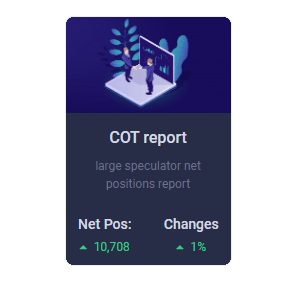
What is The Commitment of Traders (COT)?
The Commitment of Traders (COT) report is a weekly publication of net positions in the future market that is released on Fridays by CFTC commission. It is an outline for the commitment of the classified traders as commercial traders, speculators (non-commercial traders), and non-reportable traders. We use this report to understand the dynamics of the market. The commitment of commercial traders is not important for us because they take a position to hedge the value of their assets against market risks due to unfavorable price movements.
The COT report is categorized into 4 main types of traders including Dealers, Leveraged Funds, Asset Managers, and Other reportable positions.
The Dealers include banks and dealers in securities and swaps. They are not speculators in the markets so we don’t follow them in forex trading.
The Asset Manager: These are institutional investors, pension funds, mutual funds, and those portfolio managers whose clients are predominantly institutional.
The Leveraged Funds (Hedge Funds) That they are typically hedge funds and various types of money managers, including registered commodity trading advisors. The traders may be engaged in managing and conducting proprietary futures trading and trading on behalf of speculative clients. This is who we’re interested in as forex traders.
And Other Reportable, The traders in this category mostly are using markets to hedge business risk, like small and big companies, they just trade on the forex market to hedge their business risk so we don’t follow them.
The result of these 4 types of traders is divided into two types:
The commercial traders, trades to reduce the risk or trade on securities to not to make a profit. Unlike commercial traders, non-commercial traders trade to make a profit. They are large speculators who make money by investing in the future market. Non-commercial traders include hedge funds, trading advisors, and financial institutions that buy-in up-trend and sell in down-trend. Any significant change in net short or long positions of non-commercial traders will result in a trend reversal or strong momentum.
Commercial traders and No-Commercial traders (Speculators)
We have summarized this report to only show the non-commercial net positions and percentage of the changes from last week. A positive value means net long, and a negative value means net short positions.
E.g: The Ziwox terminal shows you cot data like the below image. You can see and analyze the NZD/USD pair COT data and history of change

For traders as well as Forex traders, this statistic is valuable because you can have a better view of the market. Knowing where the big and main players in the market are. It helps you to find out where the funds and hedge funds money managers in the market stand.
Now you can trade with the big market makers in the same direction with Ziwox terminal
Analysis the COT
Check the below image. chart of EURUSD, and history of the non-commercial net positions.
Non-commercial traders are big capitalists and traders are very patient and they are also called trend lovers. They usually use the average price for their buy and sell transactions. As long as the uptrend is taking place, they will keep their buy trades and sell when the average breaks down.
Non-commercial traders (speculators) of the market are the largest buyers at the lowest price levels and the major sellers of the market at high prices. You can use the trend of speculators trading as an indicator.

Our COT module:
We summarized the COT report to only show the non-commercial or Large speculator’s net positions and percentage of the changes from last week. this data helps you to understand what forces have caused price changes and helps you to know about price change potential.
you can guess when the market big kids decide to accumulation their assets or when they decide to close their positions.
Yes, you have a prediction module.
- Positive number for Net-Positions called Long Net-Position
- A negative number for NET-Position means the asset is Short Net-Position

Tips for use:
- Use it only for Medium-term decisions/trades
- Give you the Best outlook to understanding where is most of the liquidity in the market.
- Shows the hidden supply and demand of the market
- This tool is not your trade signal. use it as a confirmation for your trades
- Net position change with a range of lower +-4000 contract is the normal supply and demand. looking for a higher net change.
BUY confirmation:
- In a Long NET-POS, it’s better to looking for a buying opportunity. because most speculators are applicants for these assets and they think this asset is Worth to buy
- Big Positive changes in a short NET-POS, Is a sign of trend changes or a short-term Sell trend correction
- Buy opportunity when you have positive changes in Log NET-POS value. (more than 4K contracts). this means speculators are buying this asset more than last week
- Suddenly positive change indicates the intensity of buyers due to short-term sentiment or fundamental reasons.
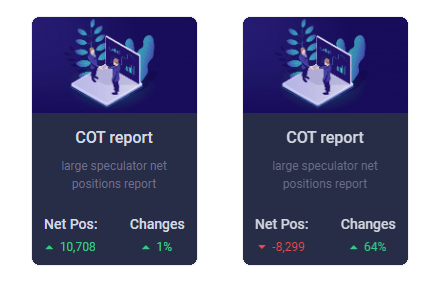
BUY positioning:
- Long-term, short NET-POS, or a big amount in a short NET-POS, is a sign of the OVERSOLD price area and speculator’s position unwinding. means it’s possible that the speculators close their short positions to take their profit. it makes a reversal correction on the price or pushes up the price for short-term
- Oversold on COT net-pos can make a good demand price area.
- Overbought on COT-Net positions for quote currency. (ex: NZD overbought on AUDNZD) and possibility for close NZD buy positions and push the pairs to higher price sake of position unwinding
SELL confirmation:
- In a short NET-POS looking for a Sell opportunity. because most speculators are in short positions and they think, the asset is worthless to buy
- Big Positive changes in short NET-POS, Is a sign of trend changes or a short-term Sell trend correction
- Buy opportunity when you have positive changes in long NET-POS value. (more than 4K contracts). this means speculators are buying this asset more than last week
- Suddenly positive change indicates the intensity of buyers due to short-term sentiment or fundamental reasons.

SELL positioning:
- Long-term Long NET-POS or huge numbers for Long Net positions is a sign of the speculator’s position unwinding and OVERBOUGHT price area. means it’s possible that the speculators close their Long positions to take their profit. it makes a price reversal/correction or pulls down the price to the downside for short-term
- Overbought on COT net-pos can make a good supply area.
- Oversold on COT-Net positions for quote currency. (ex: JPY oversold on USDJPY) and possibility for close JPY sales positions and force the pairs to lower prices sake of position unwinding
Ali Sabbaghi
December 15, 2021
Retail traders sentiment
Ziwox sentiment module
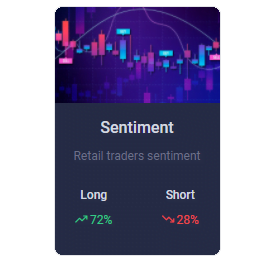
About retail traders
There are on average almost $4 billion of forex spot transactions on a daily basis.
With analysis of brokers, reports include data from over 6000 traders across the globe as well as insights and predictions from our leading traders, It shows us statistically, 85%-95% of Forex retail traders do not succeed in their trades.
Unfortunately, one of the main reasons for this loss, is that the majority of retail traders, are trend fighters and take positions against the market trend. this appears to be human nature more than logic as this pattern continues to play out. And These traders attempt to call tops and bottoms in the market by trading reversals in strong trending markets. This goes completely against the fundamental concept of, The trend is your friend.
The trend momentum will benefit too when the traders that are against the trend exit from the market.
You can see the correlation between this data with price changing and real market sentiment below for USDJPY as an example.


What is our Retail traders indicator:
The Retail Traders indicator is one of the Ziwox terminal components that shows the confrontation ratio between buyers and sellers collected from millions of traders over the forex, CFTC market. It can be used as a market sentiment that determines the buy and sell position across a range of assets. Essentially, it shows where the majority of traders are positioned and how much in the percentage they are going long and short.
This sentiment is a contrarian indicator, Because, As we talk about it at the first of this article, The majority of retail traders are trend fighters and take positions against the market trend, and given that 85% of traders, trade wrong, So to use this sentiment, look for markets exhibiting extremes in positioning. Strong up-trend or down-trend momentum combined with extreme net-short or net-long retail traders positioning, results in a bullish/bearish signal.

Tips for use:
- Use it only for Medium-term decisions/trades
- This Indicator can show you trades direction
- Determine when the traders are in a trend fight
- This indicator is not your trade signal singly. use it as a confirmation of your decision
- About 90% of traders lose their money in the market. Therefore, trading in the opposite direction from most traders can be profitable.
- Don’t trade when the Long and Short ratios are close to each other. (Log or short position between 40% and 60% )
- If most retail traders expect to drop in the price of an asset, you should consider a long position, and conversely for long expecting you should look for a short opportunity
BUY confirmation:
- Retail traders Indicator gives you BUY confirmation when you are in the Strong up-trend with most retail traders in the short positions
- Technical trend shows long-trend, But more than 60% of retail traders are in short

SELL confirmation:
- You have a SELL confirmation when you are in the Strong Dow-trend with most retail traders are in the Log positions
- Trend is Sell, But more than 60% of retail traders are in Long

Ali Sabbaghi
November 10, 2021
How to use Fundamental economic data?
Most Forex traders use technical analysis to trade on forex/stocks, but more sophisticated and successful traders tend to increase their success rate by using fundamental analysis in their trading decisions. In this article, we find out more about fundamental analysis, how to get important data, and how to use it.
What is the Fundamental analysis?
While technical analysis involves examining charts to identify patterns or trends, fundamental analysis involves examining economic data reports and news headlines. (And even random tweets from a particular world leader) Fundamental analysis is a way of looking at the Forex market by analyzing the economic, social, and political forces that may affect currency prices.
If you think about it, it makes perfect sense! Just like economics, it is supply and demand that determine prices and exchange rates.
It is easy to use supply and demand as an indicator of where the price can go. The hard part is analyzing all the factors that affect supply and demand.
In other words, you have to look at different factors to determine which country’s economy is doing well and which country’s economy is doing badly. With its help, you can have a view of prices in the future. You can say a cheap asset is being traded or it is already expensive and has a bubble.
You need to understand the reasons why and how certain events, such as rising unemployment, affect a country’s economy and monetary policy, which ultimately affect the level of demand for that country’s currency.
The idea behind this type of analysis is that if a country’s current or future economic outlook is good, that country’s currency will be more powerful. The better a country’s economy is, the more foreign businesses and investors will invest in that country. This leads to the need to buy that country’s currency to acquire that asset.
In short, this is the fundamental analysis: a good economy equals a good currency and a bad economy equals a declining currency
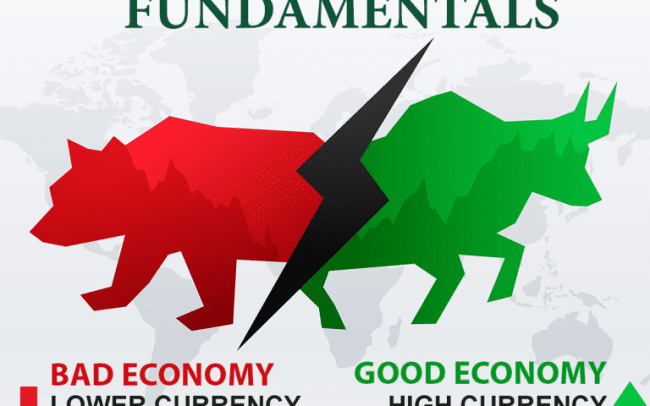
For example, when we say that the US dollar is rising because the US economy is recovering.
Note: As the economy improves, inflation will rise, and central banks may raise interest rates to control this growth and inflation.
Next, you will learn how economic data and inflation information reflect the economy.
Rising interest rates make financial assets more attractive, and traders and investors must buy that currency to acquire these lovable assets. This increases the demand for currency.
For example, suppose in your country the interest on bank accounts is 2% per annum. What will you do when a country has a bank interest rate of 3.5% ?? Here is the answer
To be able to use fundamental analysis, it is essential to understand how economic, financial, and political news affects the exchange rate. This requires a good understanding of macroeconomics and geopolitics.
Do not be afraid of words. It is enough to have a general understanding of this economic data to be able to predict potential price movements. You will learn more.
Since fundamental analysis is about examining the intrinsic value of an investment, its application to Forex requires examining the economic conditions that affect the value of a country’s currency. Here we look at some of the key factors that play a role in the currency movement.
Now, How can find this fundamental data, and how to learn it?
Indicators and economic data:
Economic indicators are reports published by a government or a private organization that details a country’s economic performance. Economic reports are a tool by which a country’s economic health is directly measured but keep in mind that many factors and policies affect a country’s economic performance.
These reports are published at scheduled times and show the market whether a country’s economy has improved or shrunk. The effects of these reports are comparable to how income reports, SEC records, and other publications may affect securities. In the Forex market, like the stock market, any deviation from the standard can cause large price and volume changes.
You may be familiar with some of these economic reports, such as unemployment data, but other statistics, such as housing statistics, are covered and less considered. However, each indicator pursues a specific goal and can be useful.
Now we will introduce these indicators:
Gross Domestic Product (GDP)
Gross domestic product is considered the broadest measure of a country’s economy and reflects the total market value of all goods and services produced in a country during a given year. Because GDP itself is often considered a backward indicator, most traders focus on two reports published in the months before the final GDP figures: the preliminary report and the preliminary report. The high difference between the previous figures and the predicted figures can cause significant fluctuations. GDP is somewhat similar to the gross profit margin of a public company because both are measures of domestic growth.
Positive and rising GDP is bullish
Retail Sales
The Retail Report identifies the statistics received by all retail stores in a country. This report is especially useful as a timely indicator of consumer spending patterns that are adjusted for seasonal variables. It can be used to predict performance and evaluate the economy. Differences in previous and current reports as well as differences with the projected figure can cause significant fluctuations. A retail report that shows the sales of stores across a country can be compared to the sales activity of a public company. The above figures show good sales and high income of companies and consequently higher inflation.
Rising retail sales is bullish for the currency
Industrial Production
This report shows the change in the production of factories, mines, and facilities within a country. It also reports the capacity utilization of each plant. It is ideal for a country to see an increase in production while at or near-maximum capacity utilization.
Traders using the index are often concerned about output and the price of utilities, which in turn will greatly affect trade and energy demand. Significant changes between reports can cause the country’s currency to fluctuate.
Slowing industrial production can lead to less employment, a reduction in the GDP, and signal an economic contraction. so
lower released data is bearish for the currency
Consumer Price Index (CPI)
The CPI measures changes in the prices of about 200 different consumer goods. This report, when compared to a country’s exports, can be used to see if a country is making a profit or loss on its products and services. However, be careful when considering exports – this is a concern for many traders because export prices often vary according to the strength or weakness of a currency.
Other key indicators include Purchasing Managers’ Index (PMI), Producer Price Index (PPI), Durable Goods Index, Employment Cost Index (ECI), and Housing Start. And don’t forget the many reports from private companies, the most famous of which is the Michigan Consumer Trust Survey. All of these, if used properly, provide a valuable resource for traders.
Rising CPI or PPI is considered bullish because it makes an interest rate hike more likely
Average earnings
The price governments and companies pay for labor. When the prices for goods that companies have to pay rise, it is usually passed on to the consumer and it could lead to a rise in consumer prices (CPI). Thus, the hourly earnings numbers are used to make decisions about interest rates because it reflects inflation. A rise in earnings can also lead to more consumer spending which is also considered bullish.
When the actual numbers be higher than forecast, it is generally good for the currency
Building permits
The value of building permits for the construction of new houses. Building permits are considered a leading economic indicator because a rise in building permits can foreshadow rising demand for construction, material, and labor when the actual construction of the homes starts. When the actual numbers beat the forecast, it is generally considered bullish.
A higher number is bullish for the currency
FOMC
FOMC meeting is the highest important event on the forex calendar and can lead to a lot of volatility and market prices. During the FOMC meetings, monetary policies are being discussed. During the FOMC meeting, the participants also vote about potential interest rate decisions (raising or lowering interest rates) and also provide a potential outlook of the economy.
Flash Manufacturing
A survey of purchasing managers in the manufacturing industry. The survey includes business activities, employment, production, orders, prices, and supplier deliveries. Purchasing managers are highly informed and the outcome of the survey is considered a leading economic indicator about the health of the manufacturing industry and the economy as a whole.
Positive data suggest a healthy and growing economy that is bullish
NFP – Nonfarm payrolls
NFP data shows the employment numbers of paid workers in the US, excluding government employees, private household employees, and farm employees. The NFP is released monthly and provides information about the health of the economy. The NFP numbers can also serve as a proxy for how likely government activity is
Higher value is good for currency
Unemployment claims
The unemployment claims show how many people have filed for unemployment. Unemployment claims is an important number because it also affects consumer spending behavior and shows the state of the economy.
A higher number is considered bearish
Use of economic index
Because economic indicators measure a country’s economic situation, changes in reported conditions directly affect a country’s price and money supply. However, it is important to keep in mind that the indicators discussed above are not the only ones that affect currency prices. Reports from important people, speeches, tweets of senators and representatives of the country, political tensions, and many technical factors can also greatly affect the value of a currency. When doing fundamental analysis in the Forex market:
Have an economic calendar available that lists the indicators and when they were published. Also, be careful about the future. Most markets move in anticipation of a specific indicator or report to be released at a later time and push the price forward. But if the report or what was expected was different, the fluctuations will intensify.
Find out the economic indicators that are attracting more and more market attention at any given time. Such indicators are the catalyst for most price and volume movements. For example, when the US dollar is weak, inflation is often one of the indicators.
Know the market expectations for the data and then pay attention to meeting the expectations. This is much more important than the data itself. Sometimes, there is a huge difference between expectations and actual results. If so, be aware of the possible justifications for this difference.
Do not react to the news too quickly. Most numbers are published and then corrected and everything can change quickly. Pay attention to these corrections, as they may be a useful tool for monitoring trends and responding more accurately to future reports.
On the Ziwox terminal, you can find the fundamental analysis and the final result of the analysis for every currency.
It is an overview of currency pair fundamental analysis based on economic news and currency economy outlook. It shows you whether the current bias is Bullish or Bearish with a power stretch. This indicator shows the currency’s potential to grow or decline in futures and power/stretch shows the speed of these changes.
source: tradeciety, dailyfx, Innvestopedia
Ali Sabbaghi
May 25, 2021
USD – Mildly bearish cruising speed
The week has started off on an upbeat note for risk sentiment as recently troubled US tech stocks led a broader rally in the equity segment yesterday. The dollar, in a week without major idiosyncratic drivers, has stayed mildly offered. Today, external factors will remain in the driving seat, with the US data calendar still very light and some Fedspeak that has so far disappointed any hawkish expectations in the market. Yesterday, three Fed officials (Brainard, Bostic, and Bullard) all played down concerns about persisting inflation. This has been the strongly prevailing tone since the surprisingly high inflation read for April and it may be by and large what we will hear today from Evans, Barkin, and Quarles (the latter at a Senate testimony), if any monetary-policy comments are made at all. The dollar may therefore remain broadly-offered for the time being, with commodity currencies still reaping most of the benefits thanks to a strong start to the week in the commodity segment and the broadly supportive risk environment. CAD is, for once, lagging other pro-cyclical, which may be due to its positioning being quite markedly skewed on the long side.
#usd #usa #analysis
Ali Sabbaghi
March 18, 2021
How to Use the Gold-to-Silver Ratio?
We have debunked the myth that the gold-to-silver ratio should revert to its “true” level around 16. The predominant range for the ratio in modern times is rather well between 40 and 80. Moreover, the notion that the gold-to-silver ratio should revert to some historical average makes no sense. The relative valuation between these two precious metals depends on market forces, like the health of the world economy and monetary demand for both metals or industrial demand for silver. Such factors change over time. For example, gold has nowadays much higher monetary demand compared to silver than in the past, which largely explains why the average ratio in the 21st century was on average higher than earlier.
What else can we learn from the analysis of the historical gold-to-silver ratio? Well, the chart below shows an interesting pattern. The peaks in the ratio are bullish signals, while the bottoms are bearish. Indeed, the gold-to-silver ratio peaked in 2003 and later in 2008, pretty good moments to invest in both gold and silver. Similarly, the bottom in 2011 was an important selling signal, was it not?
Chart 1: The gold-to-silver ratio (the price of gold divided by the price of silver, red line, right axis), the price of gold (yellow line, left axis, London A.M. Fix), and the price of silver (blue line, right axis, London Fix) from 2002 to May 12, 2016.
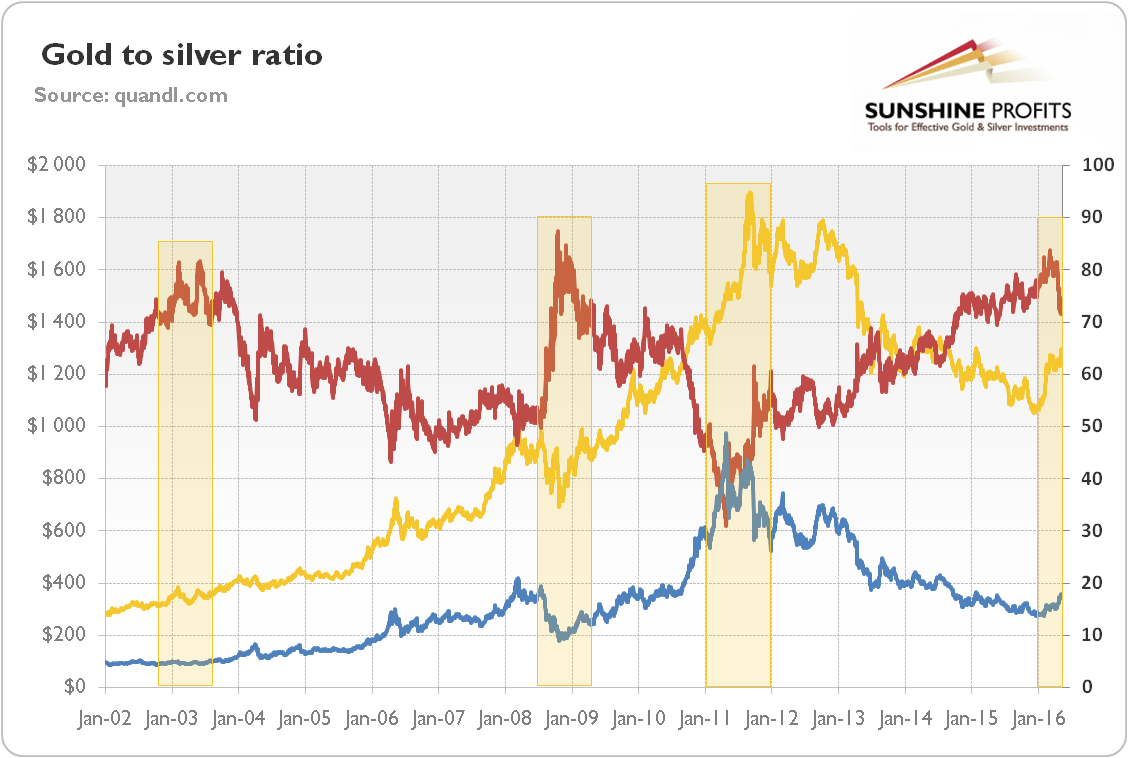
Well, gold leads the dance and silver usually follows
What determines such a tendency? Well, gold leads the dance and silver usually follows. Therefore, during bull markets in the precious metals, gold starts to rally earlier, while silver lags and only later catches up with gold. It makes sense since silver functions mainly as an industrial metal. This is why at the beginning of a precious metals boom, the gold-to-silver ratio increases. As the gold boom intensifies, silver investors also jump on the wagon (we can say that they recall the monetary function of silver and its close relationship with gold, or that the silver market, due to low and volatile silver prices compared to gold, attracts speculators who want to participate in a bull market). The price of silver catches up with gold, so the gold-to-silver ratio declines.
How to use this ratio?
How then can precious metals investors use the gold-to-silver ratio in investing? It should already be clear that when the ratio moves to extremes, it creates a gold and silver trading opportunity for investors. When the ratio is low, it indicates that silver may be overvalued (which is logically equivalent to gold being undervalued). Therefore, if gold buys less than, let’s say, 40 ounces of silver, it may be time to sell silver and buy gold. Similarly, when the ratio is high, it signals that silver may be undervalued. Thus, if gold buys more than, let’s say, 80 ounces of silver, it may be time to buy silver and sell gold.
Another idea would be to view extremes in the ratio as turning points in the entire precious metals sector – the bigger the extreme, the bigger turnaround it could indicate.
However, there is a crucial caveat. Nobody knows for sure the turning point when investors should switch between precious metals. The ratio may hit 80 (or 40) and continue to expand (dive) for a while, as the fundamentals may change, justifying a new range for the ratio. History does not repeat itself, it only rhymes.
It is important to realize that the decline in the gold-to-silver ratio may correspond with the bull market in both silver and gold – the key to understanding this is the fact that precious metals tend to move in tandem, but gold precedes silver, as mentioned previously. Since the latter accelerates later and acts like “gold on steroids” (silver is more volatile than gold both during upside and downside moves), investing in silver increases potential profits, but also potential losses compared to gold. In other words, the gold-to-silver ratio may signal a trend in both metals. If the ratio is high (let’s say above 80), investors should increase their position in silver relative to gold, but they do not have to actually sell gold. The price of gold in silver ounces is likely to decline, but it does not mean that the U.S. dollar price of gold is also going to drop. Actually, the absolute price of gold should also increase, although at a slower pace than silver prices.
Let’s analyze the chart below to find out what the gold-to-silver ratio tells about the current state of the precious metals market.
Chart 2: The gold-to-silver ratio (the price of gold divided by the price of silver, red line, right axis), the price of gold (yellow line, left axis, London A.M. Fix) and the price of silver (blue line, right axis, London Fix) from 2013 to May 31, 2016
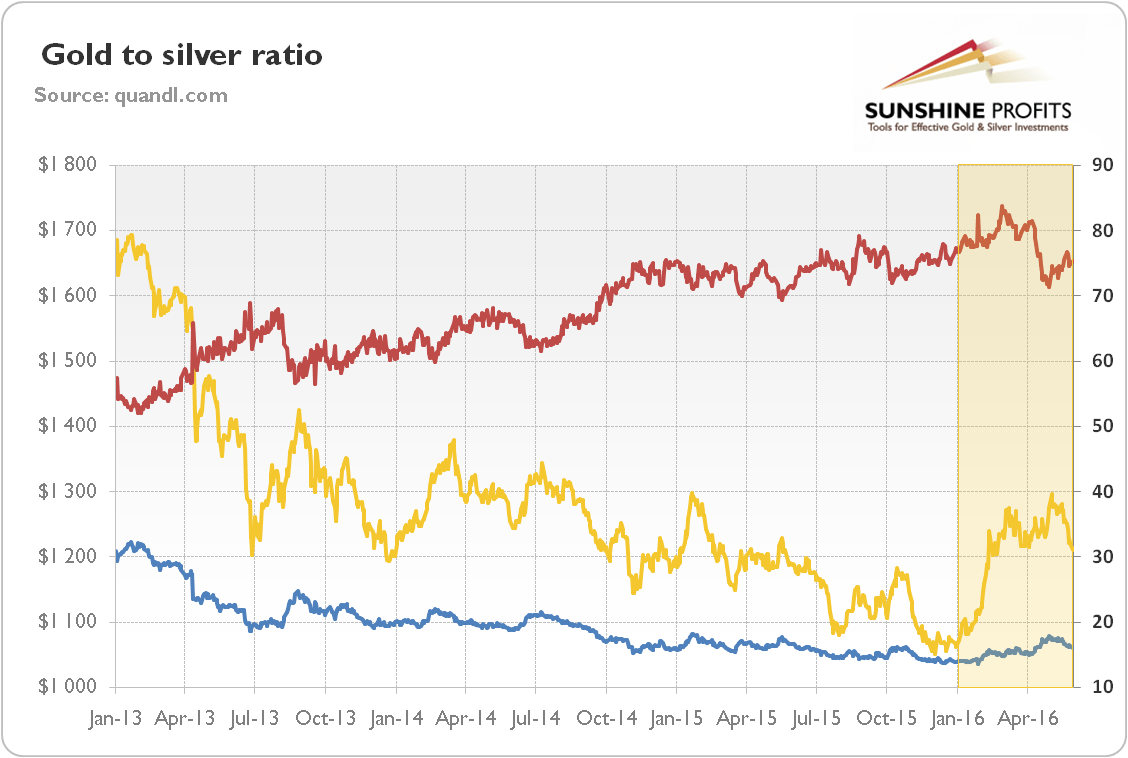
As one can see, the gold-to-silver ratio pushed above 80 in January 2016, reaching a level not seen since 2008. This may signal that gold and silver may begin a new bull market (it, however, doesn’t rule out another big drop in prices, before an expected bull market would begin). It goes without saying that the peak in the ratio may also indicate a recession (just like in 2008) or at least an important economic slowdown. When the economy is slowing down, the industrial demand for silver suffers, while the price of gold is supported by safe-haven bids. However, the ratio started to decline in April. The drop from the peak came because of an increase in silver prices in April. Silver underperformed gold in the first quarter of 2016, but it accelerated in April. Indeed, the decline in the ratio indicated that silver was rising faster than gold. However, in May the ratio rebounded, as silver decreased more than gold. Despite the recent decline, the ratio is still at a relatively elevated level.
If you enjoyed the above analysis and would you like to know more about the gold-to-precious metals ratios, we invite you to read the June Market Overview report. If you’re interested in the detailed price analysis and price projections with targets, we invite you to sign up for our Gold & Silver Trading Alerts. If you’re not ready to subscribe at this time, we invite you to sign up for our gold newsletter and stay up-to-date with our latest free articles. It’s free and you can unsubscribe anytime.
source: fxstreet.com
author: Arkadiusz Sieroń
Leave a Reply Cancel reply
You must be logged in to post a comment.
Ali Sabbaghi


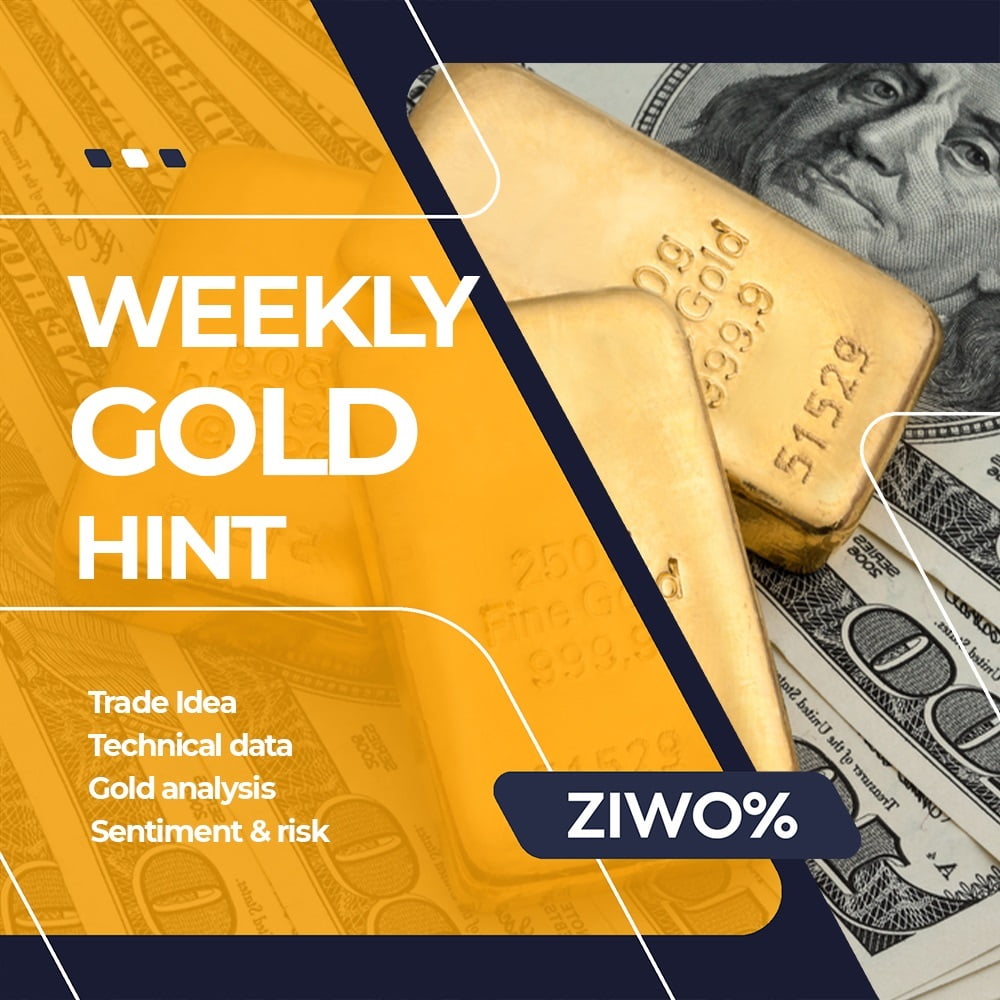

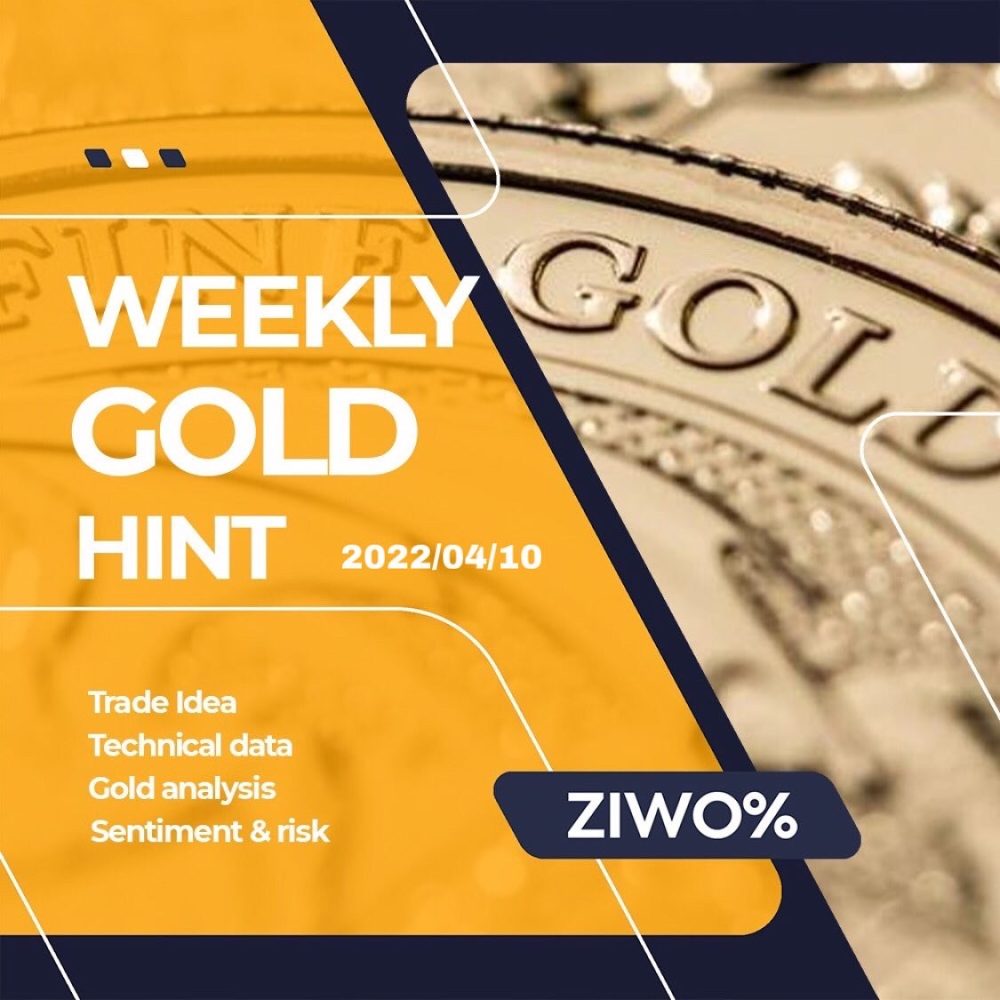
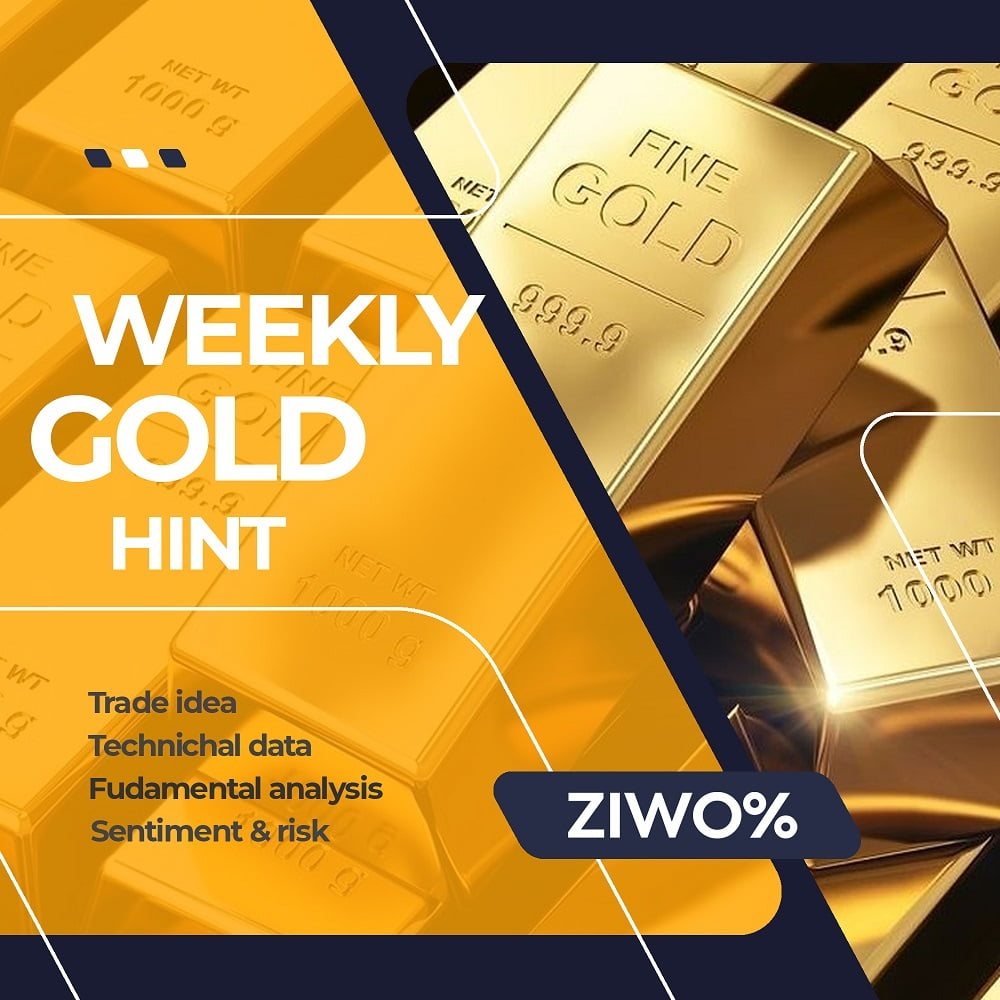

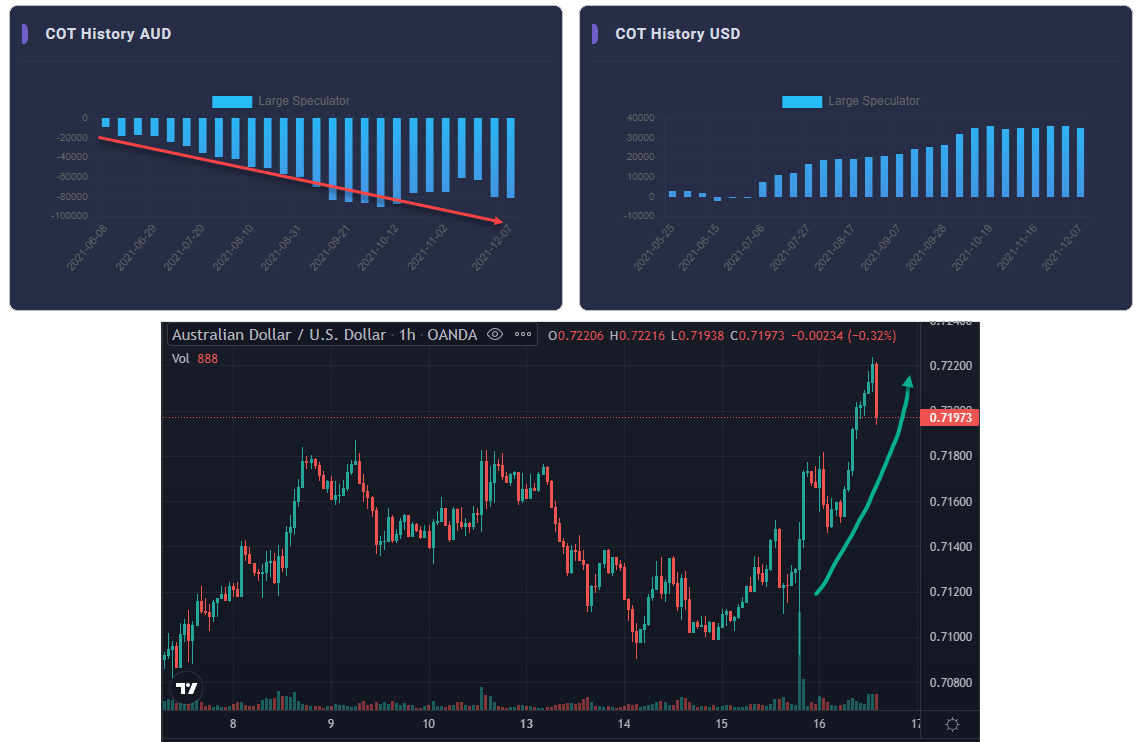
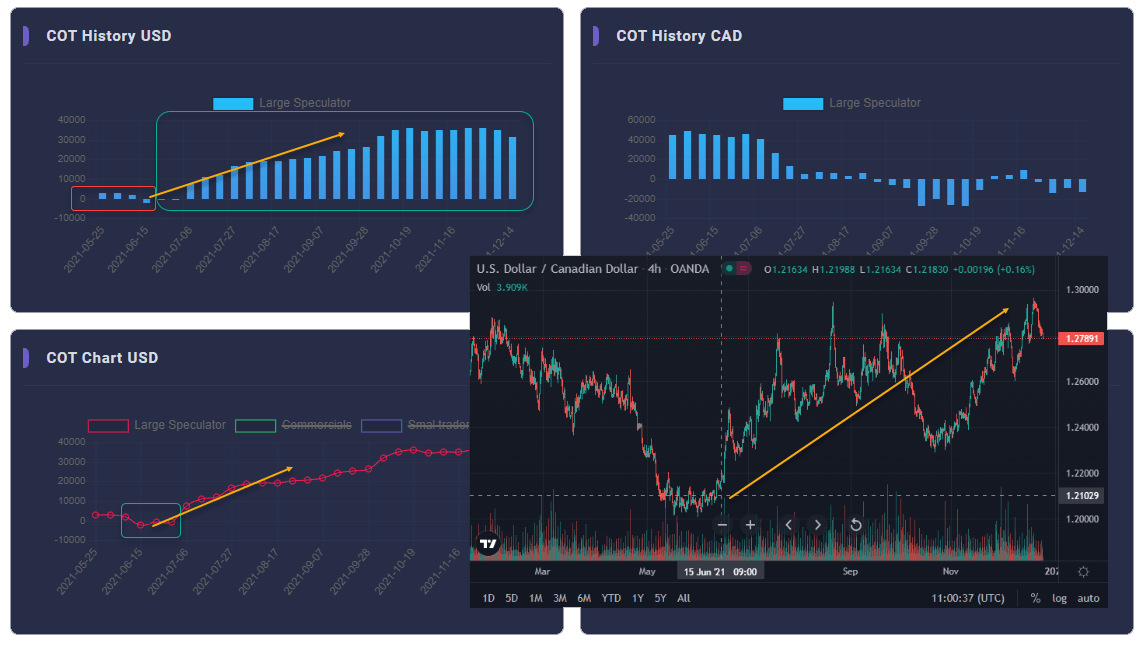
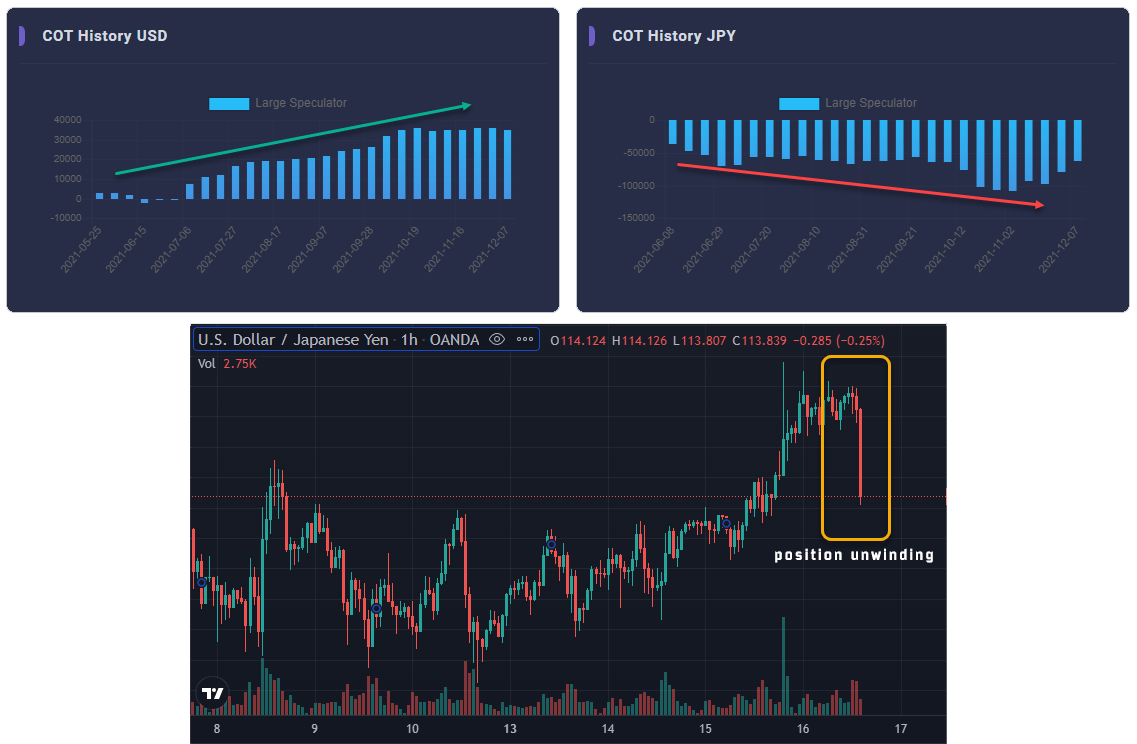
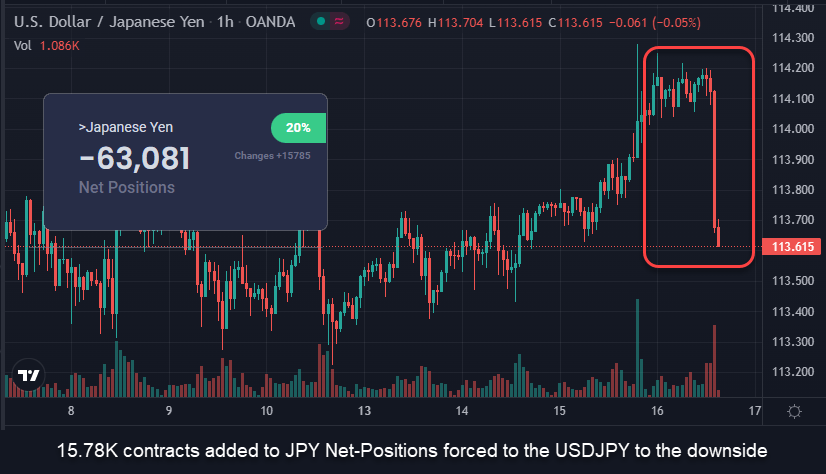
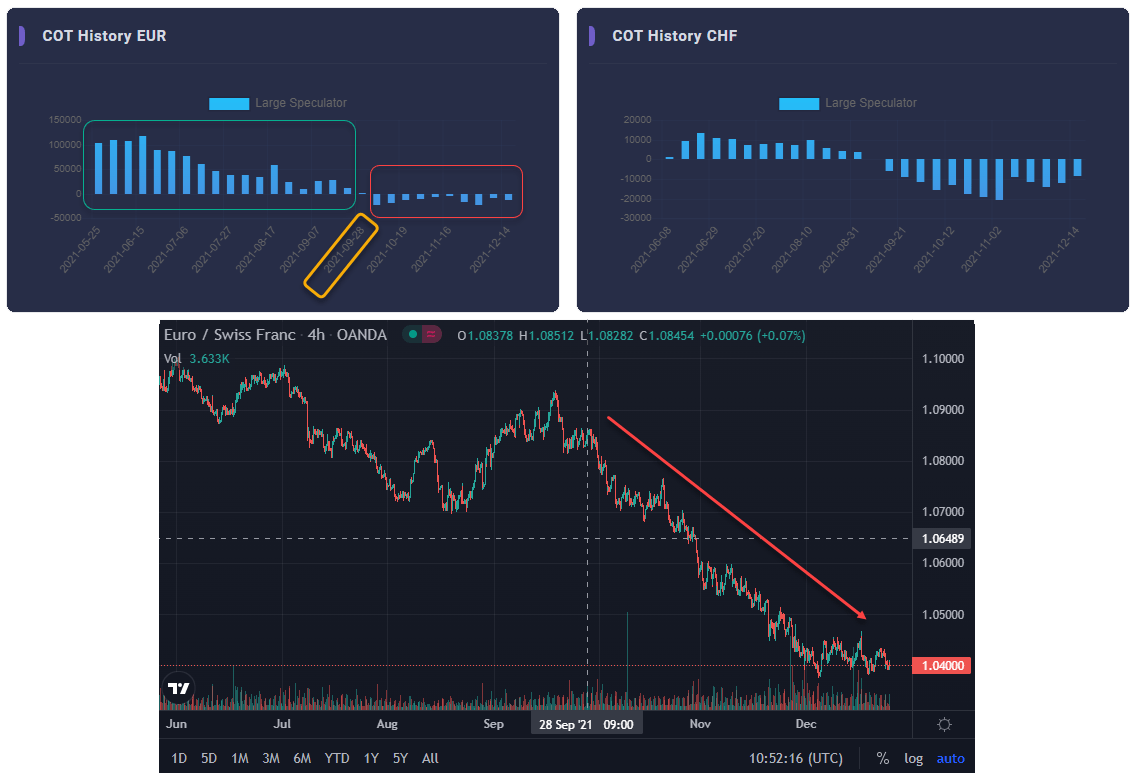





Leave a Reply
You must be logged in to post a comment.